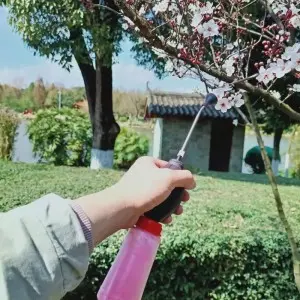Oct . 05, 2025 23:25 Back to list
Artificial Pollination Made Easy: Higher Yields, Lower Risk?
Field Notes: LITHIUM ELECTRIC POLLINATOR FOR ORCHARD and the new wave of artificial pollination
If you’ve managed an orchard lately, you already know: climate swings, bee shortages, and compressed flowering windows make pollination the make-or-break moment. The Lithium Electric Pollinator from Hebei (yes, the one with a utility-model patent in the works) has been turning heads for a simple reason—it’s practical. It’s been studied for five years, and it shows.

What it is, where it’s from
Product: LITHIUM ELECTRIC POLLINATOR FOR ORCHARD. Origin: Caozhuang Development Zone, Fanzhuang Town, Zhao county, Shijiazhuang, Hebei Province. Core components: lithium battery, electric motor, powder storage tank, and extension rod. It’s designed for medium-sized orchards—about 10–20 mu (≈0.67–1.33 hectares). To be honest, that’s the sweet spot many growers ask about.
Why now? Industry trends in plain language
Growers are shifting to artificial pollination for timing control, uniform set, and risk hedging when natural pollinators underperform. Electrified tools reduce labor bottlenecks, and lithium packs mean longer field time. I’ve seen co-ops renting units by the day—surprisingly effective for clustered bloom periods.

Process flow (materials, methods, testing)
Materials: clean, viable pollen; the unit’s sealed powder tank; extension rod attachments. Methods: dry and sieve pollen, load tank, set motor speed, and walk row-by-row at steady pace; two passes during peak bloom are common. Testing: growers typically tag sample branches and track fruit set after 10–14 days. Safety and quality: request battery conformity (IEC 62133) and transport tests (UN 38.3). For durability, ask about dust/splash ingress ratings (e.g., IP54) and QC under ISO 9001. Service life is often ≈3–5 seasons with routine cleaning and battery rotation—real-world use may vary.
| Parameter | Specification (≈/as supplied) |
| Product | LITHIUM ELECTRIC POLLINATOR FOR ORCHARD |
| Origin | Caozhuang Development Zone, Fanzhuang Town, Zhao county, Shijiazhuang, Hebei Province |
| Power | Rechargeable lithium battery; swap-friendly pack |
| Drive/Motor | Electric motor with adjustable output |
| Powder tank | Sealed, easy-clean reservoir for pollen |
| Extension rod | Adjustable for canopy reach |
| Orchard size | Best for ≈10–20 mu; two-pass schedules common |
| Compliance | Request IEC 62133, UN 38.3; CE/RoHS on electronics (regionally) |
Application scenarios and results
Crops: apple, pear, cherry, kiwifruit; greenhouse ornamentals. Terrain: flat-to-gentle slopes; the extension rod helps under dense canopies. In one Hebei apple block, the farm manager told me they measured steadier fruit set after rain-washed bloom—no miracles, just reliability. Another greenhouse team used artificial pollination to synchronize harvest windows before a holiday shipment. It seems that, with trained operators, uniform coverage improves.
Vendor comparison (quick take)
| Vendor | Pros | Considerations |
| JML (Lithium Electric Pollinator) | Patent-backed design; medium-orchard focus; local spares | Confirm battery certifications per market |
| Import Brand S | Broad distribution; accessories ecosystem | Lead times; cost premium |
| DIY Retrofits | Lowest upfront cost | Inconsistent output; safety paperwork often missing |

Customization, service, and what customers say
Options often requested: larger powder tanks, alternative diffuser nozzles, longer rods, and spare battery packs for long days. Many customers say the unit feels lighter than expected and “easier to clean than the old rigs.” For compliance, ask for IEC 62133 test reports, UN 38.3 transport docs, and factory ISO 9001/14001. For artificial pollination audits, track blossom counts, operator speed, and post-bloom set—boring but essential.
Bottom line
If you’re juggling short bloom windows, a lithium pollinator is not a luxury; it’s insurance. The Hebei-built unit hits the practical middle: capable in 10–20 mu blocks, simple to maintain, paperwork-friendly when you ask for the right certificates. And yes, artificial pollination still needs skilled hands—this just makes those hands more efficient.
- FAO. Pollination of Cultivated Plants: A Compendium for Practitioners. Food and Agriculture Organization.
- IEC 62133. Secondary cells and batteries containing alkaline or other non-acid electrolytes — Safety requirements.
- UN Manual of Tests and Criteria, Section 38.3 (UN 38.3) — Lithium battery transport tests.
- ISO 9001 and ISO 14001 — Quality and Environmental Management Systems.
-
Comprehensive Guide to CE Certification Apricot Pollen Health Benefits
NewsNov.24,2025
-
CE Certification Mango Fruit Protection Bags: Enhancing Export Quality & Sustainability
NewsNov.23,2025
-
CE Certification Varieties Suitable for Collecting Apple Pollen – Ensuring Quality & Compliance in Apple Breeding
NewsNov.22,2025
-
Comprehensive Guide to CE Certification Mango Cover Bags – Quality, Standards & Trends
NewsNov.22,2025
-
What You Need to Know About CE Certification Peach Blossom Powder Keto
NewsNov.21,2025
-
CE Certification Pear Pollen Collection Base – Ensuring Quality & Sustainability in Global Horticulture
NewsNov.20,2025